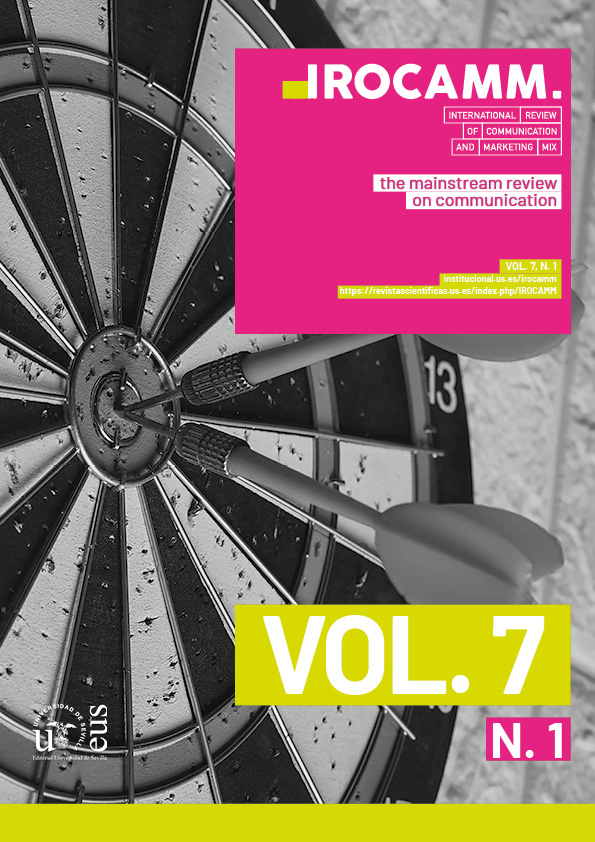Resumen
Esta investigación trata de comprobar la hipótesis que se deriva del discurso de la actriz Adelfa Calvo por la igualdad al recoger el Premio Goya a Mejor Actriz de Reparto en 2018. También pretende reconocer otras de sus acciones feministas en el cine. El objetivo principal ha sido contextualizar su discurso probando que ha existido una a premiar actrices según la edad y la talla en la última década. Para comprobarla se ha analizado la muestra de actrices que recogen el galardón entre 2010 y 2020 analizando las variables mencionadas. La metodología utilizada ha combinado el análisis de contenido cualitativo y cuantitativo con entrevistas personales y el estudio de caso. Los resultados han demostrado que la hipótesis se cumple. La conclusión más reseñable ha sido la detección de la necesidad de una normativa que regule esta tendencia discriminatoria basada en la educación en la igualdad. Probar científicamente que el trabajo de las actrices en Premios Goya ha sido valorado influido por una tendencia al margen de criterios profesionales es la aportación de esta investigación. Al mismo tiempo que reconocer a Adelfa Calvo como referente de la industria cinematográfica en la lucha feminista por su mediática reivindicación.
Citas
Academia de las Artes y las Ciencias Cinematográficas. (29 de diciembre de 2022). Ediciones anteriores. Premiosgoya. Recuperado el día 30 diciembre 2022 de https://bit.ly/3ZPATTe
Berlanga Fernández, I., & Fernández-Ramírez, L. (2020). Cine y youtubers, nuevas audiencias, nuevas experiencias. Tsafiqui: Revista científica en ciencias sociales, 15, 45–56. https://doi.org/10.29019/tsafiqui.v11i15.806
Bernández-Rodal, A., & Padilla-Castillo, G. (2018). Mujeres cineastas y mujeres representadas en el cine comercial español (2001-2016). Revista Latina de Comunicación Social, (73), 1247–1266. https://doi.org/10.4185/RLCS-2018-1305
Bulloni, M., Justo von Lurzer, C., Liska, M., & Mauro, K. (2022). Mujeres en las artes del espectáculo: Condiciones laborales, demandas de derechos y activismos de género (Argentina, 2015-2020). Descentrada. Revista interdisciplinaria de feminismos y género, 6(1), e161. https://doi.org/10.24215/25457284e161
EFE. (2011). Los menores de dieciséis años no podrán optar a un Goya. El Diario de Sevilla. https://bit.ly/3ZXvXMb
Europa Press. (2011). AMPL. Los menores de 16 años no podrán optar a ninguna categoría en los Premios Goya. https://www.europapress.es/cultura/cine-00128/noticia-ampl-menores-16-anos-no-podran-optar-ninguna-categoria-premios-goya-20110621150015.html
Fiacine. (2022). Estudio Anual Fiacine Mujeres. Participación de la Mujer en la Industria Cinematrográfica Iberoamericana. FIACINE, 1-148. https://bit.ly/3LpInYT
Garrido-Reina, P., González-Portillo, A., & Ruiz-Ballesteros, E. (2022). Hacia una Intervención Social Feminista en el contexto de las violencias machistas. Prisma Social, revista de investigación social, (38), 201–220.
Gordillo, I. (2010). La mujer “envejeciente”: silencios, estereotipos y miradas en el cine de la primera década del siglo XXI. En P. Sangro & J. F. Plaza (Eds.), La representación de las mujeres en el cine y la televisión contemporáneo (pp. 97–117). Laertes.
Guarinos, V. (2008). Los medios de comunicación con mirada de género. En F. Loscertales & T. Núñez (Eds.), Mujer y cine (pp. 103–120). Instituto Andaluz de la Mujer.
Jiménez-Marín, G., Simancas-González, E., & González-Oñate, C. (2022). La publicidad: Estructura de la industria en España. Del cliente a la agencia (y viceversa). Pirámide.
Jurado González, J. (2018). Mujer, roles de género y política de premios en el cine español (1940-1959). Investigaciones feministas, 9(1), 119–135. https://doi.org/10.5209/INFE.56014
Martín Rojas, J. L. (2023). Susi Sánchez, favorita en los Premios Goya 2023, confiesa que perdió varios papeles debido a su homosexualidad. La Vanguardia. https://bit.ly/3YNebtz
Martín Cuenca, M. (Director). (2017). El autor [Película]. Icónica Producciones, Lazona Films y La Loma Blanca PC.
McGowan, N., & Yáñez-Martínez, B. (2022). Ni nominadas ni ganadoras: Las mujeres en los Premios Goya (1987- 2021). Área Abierta. Revista de comunicación audiovisual y publicitaria, 22(2), 131–154. https://doi.org/10.5209/arab.79909
Meliveo Nogués, P., & Cristófol-Rodríguez, C. (2021). Reivindicación de las representaciones femeninas en el audiovisual español: Estudio de una década de arquetipos de mujeres en los premios Goya. Revista de Ciencias de la Comunicación e Información, (26), 39–57. https://doi.org/10.35742/rcci.2021.26.e138
Premios Goya. (2018) Adelfa Calvo, Goya a la Mejor Actriz de Reparto 2018. https://www.youtube.com/watch?v=g6C0CVjlV9s
Pulido, M., & Vázquez-González, J. (2019). Public relations and events: The organization of festivals as a tool for cultural promotion. IROCAMM -. International Review Of Communication And Marketing Mix, 2(2), 13–23. https://doi.org/10.12795/IROCAMM.2019.v02.i02.02
Ramírez, N. (2017). ‘Más personajes femeninos’. Los Goya se ponen feministas. El País. https://bit.ly/3mXkC04
Rodrigáñez, L. (2023). Berta Vázquez, su inesperado trending topic en los Goya y una respuesta al mundo. Telva. https://bit.ly/3EMeXiS
Rodríguez Sánchez, J. (2012). La mujer en el cine español. Arkadin.
RTVE. (2023). La familia de Carlos Saura recibe el Goya de Honor. Premios GOYA 2023. https://www.youtube.com/watch?v=ub3Zg1i1CXY
Tello Díaz, L. (2016). La “mirada femenina”: Estereotipos y roles de género en el cine español (1918-2015). Ámbitos. Revista Internacional de Comunicación, (34). https://revistascientificas.us.es/index.php/Ambitos/article/view/9303
Uceda, Q. (2023). Sara Sálamo deslumbra sin maquillaje en los Goya.”Para que nos sintamos cómodas siendo nosotras mismas”. La Vanguardia. https://bit.ly/46nm4ue
Villén Higueras, S. J. (2020). La promoción cinematográfica en las redes sociales: Un enfoque desde los directores de cine español. IROCAMM -. International Review Of Communication And Marketing Mix, 2(3), 96–108. https://doi.org/10.12795/IROCAMM.2020.v02.i03.07
Villodres, M. (2018). Los Goya 2018: una gala ‘feminista’ presentada, dirigida y escrita por hombres. El País. https://bit.ly/3ZSUwde
Wimmer, R. D., & Dominick, J. R. (2013). La investigación científica de los medios de comunicación. Una introducción a sus métodos. Bosch Casa Editorial S.A.

Esta obra está bajo una licencia internacional Creative Commons Atribución-NoComercial-CompartirIgual 4.0.
Derechos de autor 2023 IROCAMM - International Review Of Communication And Marketing Mix



